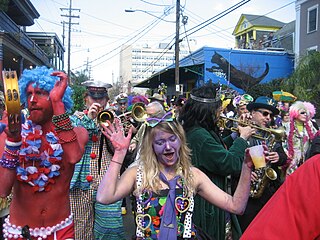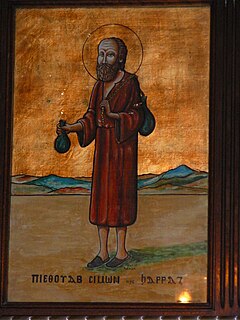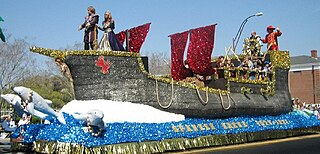
Mardi Gras, or Fat Tuesday, refers to events of the Carnival celebration, beginning on or after the Christian feasts of the Epiphany and culminating on the day before Ash Wednesday. Mardi Gras is French for "Fat Tuesday", reflecting the practice of the last night of eating rich, fatty foods before the ritual fasting of the Lenten season.
The Mistick Krewe of Comus, founded in 1856, is a New Orleans, Louisiana Carnival krewe. It is the oldest continuous organization of New Orleans Mardi Gras festivities.
Rex is a New Orleans Carnival Krewe which stages one of the city's most celebrated parades on Mardi Gras Day. Rex is Latin for "King", and Rex reigns as "The King of Carnival".

Following the Islamic conquest in 639 AD, Lower Egypt was ruled at first by governors acting in the name of the Rashidun Caliphs and then the Ummayad Caliphs in Damascus, but in 747 the Ummayads were overthrown. Throughout the Islamic rule, Askar was named the capital and housed the ruling administration. The conquest led to two separate provinces all under one ruler: Upper and Lower Egypt. These two very distinct regions would be heavily governed by the military and followed the demands handed down by the governor of Egypt and imposed by the heads of their communities.

The holiday of Mardi Gras is celebrated in all of Louisiana, including the city of New Orleans. Celebrations are concentrated for about two weeks before and through Shrove Tuesday, the day before Ash Wednesday. Usually there is one major parade each day ; many days have several large parades. The largest and most elaborate parades take place the last five days of the Mardi Gras season. In the final week, many events occur throughout New Orleans and surrounding communities, including parades and balls.

A king cake is a type of cake associated in a number of countries with the festival of Epiphany at the end of the Christmas season; in other places, it is associated with the pre-Lenten celebrations of Mardi Gras/Carnival.
The Krewe of Endymion is a New Orleans Mardi Gras super krewe and social organization.
The Krewe of OAK is a small neighborhood New Orleans Mardi Gras krewe and parade held in the Carrollton neighborhood of New Orleans, Louisiana. The parade starts and ends on Oak Street, presumably the origin of the name, although members say that OAK stands for "Outrageous And Kinky".

Simon the Tanner, also known as Saint Simon the Shoemaker is the Coptic Orthodox saint associated with the story of the moving the Mokattam Mountain in Cairo, Egypt, during the rule of the Muslim Fatimid Caliph al-Muizz Lideenillah (953–975) while Abraham the Syrian was the Pope of the Coptic Orthodox Church of Alexandria.

The Orleans Arena is a 9,500-seat multi-purpose arena in Paradise, Nevada, in the Las Vegas Valley. It is located at the Orleans Hotel and Casino and is operated by Coast Casinos, a subsidiary of Boyd Gaming Corporation.

Carnival Conquest is a Conquest-class cruise ship owned and operated by American/British company Carnival Cruise Line. Sixty percent of her staterooms have ocean views, and sixty percent of those have balconies. The ship's interior decor is of a French Impressionist style designed to complement the port city of New Orleans. Carnival Conquest was renovated in 2009.

Mardi Gras is the annual Carnival celebration in Mobile, Alabama. It is the oldest annual Carnival celebration in the United States, started by Frenchman Nicholas Langlois in 1703 when Mobile was the capital of Louisiana. This was fifteen years before New Orleans was founded, although today their celebrations are much more widely known for all the current traditions such as masked balls, parades, floats and throws were first created there. From Mobile being the first capital of French Louisiana (1702), the festival began as a French Catholic tradition. Mardi Gras in Mobile has now evolved into a mainstream multi-week celebration across the spectrum of cultures in Mobile, becoming school holidays for the final Monday and Tuesday, regardless of religious affiliation.

A mystic society is a Mardi Gras social organization in Mobile, Alabama, that presents parades and/or balls for the enjoyment of its members, guests, and the public. The New Orleans Krewe is patterned after Mobile's Mystics. The societies have been based in class, economic and racial groups. Mobile's parading mystic societies build colorful Carnival floats and create costumes around each year's themes.

Mardi Gras in the United States is not observed nationally across the country, however a number of cities and regions in the U.S. have notable Carnival celebrations. Most trace their Mardi Gras celebrations to French, Spanish, and other colonial influences on the settlements over their history. The earliest Carnival celebration in North America occurred at a place on the west bank of the Mississippi river about 60 miles downriver from where New Orleans is today; this Mardi Gras on the 3rd of March 1699 and in honor of this holiday, Pierre Le Moyne, Sieur d'Iberville, a 38-year-old French Canadian, named the spot Point du Mardi Gras near Fort Jackson. The earliest organized Carnival celebrations occurred in Mobile, Biloxi, New Orleans, and Pensacola, which have each developed separate traditions. In addition, modern activities generally vary from city to city across the U.S.

The Krewe du Vieux is a New Orleans Mardi Gras krewe more fully known as the Krewe du Vieux Carré.
Krewe of Proteus is a New Orleans Mardi Gras krewe.

The 2013 Tulane Green Wave football team represented Tulane University in the 2013 NCAA Division I FBS football season. They were led by second year head coach Curtis Johnson and played home games at the Mercedes-Benz Superdome. They were a member of Conference USA in the West Division. This was the Green Wave's last season playing in the Superdome and Conference USA as they will open the new, on-campus Yulman Stadium in the fall of 2014, and move to the American Athletic Conference in July 2014. They finished the season 7–6, 5–3 in C-USA play to finish in fourth place in the West Division. They were invited to the New Orleans Bowl where they lost to Louisiana–Lafayette.
Traditional Carnival in New Orleans has a long and well-documented history. Literally, hundreds of books and articles have been written on the subject. However, very few even mention the often hidden world of gay Carnival. Gay men, in particular, would meet during the Carnival season each year at private costume parties to view parades and celebrate as a group. However, by the late 1950s, despite the effort of the mayor and district attorney to clean up the city and the targeting gay men in particular, the first gay krewes were formed and held their own tableau balls.

The Krewe of Cleopatra is an all female krewe and social organization.














